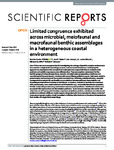Limited congruence exhibited across microbial, meiofaunal and macrofaunal benthic assemblages in a heterogeneous coastal environment
| dc.contributor.author | Cronin-O’Reilly, S | |
| dc.contributor.author | Taylor, JD | |
| dc.contributor.author | Jermyn, I | |
| dc.contributor.author | Allcock, AL | |
| dc.contributor.author | Cunliffe, Michael | |
| dc.contributor.author | Johnson, MP | |
| dc.date.accessioned | 2020-06-20T08:57:57Z | |
| dc.date.issued | 2018-10-19 | |
| dc.identifier.issn | 2045-2322 | |
| dc.identifier.issn | 2045-2322 | |
| dc.identifier.other | 15500 | |
| dc.identifier.uri | http://hdl.handle.net/10026.1/15783 | |
| dc.description.abstract |
<jats:title>Abstract</jats:title><jats:p>One of the most common approaches for investigating the ecology of spatially complex environments is to examine a single biotic assemblage present, such as macroinvertebrates. Underlying this approach are assumptions that sampled and unsampled taxa respond similarly to environmental gradients and exhibit congruence across different sites. These assumptions were tested for five benthic groups of various sizes (archaea, bacteria, microbial eukaryotes/protists, meiofauna and macrofauna) in Plymouth Sound, a harbour with many different pollution sources. Sediments varied in granulometry, hydrocarbon and trace metal concentrations. Following variable reduction, canonical correspondence analysis did not identify any associations between sediment characteristics and assemblage composition of archaea or macrofauna. In contrast, variation in bacteria was associated with granulometry, trace metal variations and bioturbation (e.g. community bioturbation potential). Protists varied with granulometry, hydrocarbon and trace metal predictors. Meiofaunal variation was associated with hydrocarbon and bioturbation predictors. Taxon turnover between sites varied with only three out of 10 group pairs showing congruence (meiofauna-protists, meiofauna-macrofauna and protists-macrofauna). While our results support using eukaryotic taxa as proxies for others, the lack of congruence suggests caution should be applied to inferring wider indicator or functional interpretations from studies of a single biotic assemblage.</jats:p> | |
| dc.format.extent | 15500- | |
| dc.format.medium | Electronic | |
| dc.language | en | |
| dc.language.iso | en | |
| dc.publisher | Springer Science and Business Media LLC | |
| dc.subject | Animals | |
| dc.subject | Bacteria | |
| dc.subject | Biodiversity | |
| dc.subject | Ecosystem | |
| dc.subject | England | |
| dc.subject | Environmental Pollution | |
| dc.subject | Geologic Sediments | |
| dc.subject | Hydrocarbons | |
| dc.subject | Phylogeny | |
| dc.subject | Principal Component Analysis | |
| dc.title | Limited congruence exhibited across microbial, meiofaunal and macrofaunal benthic assemblages in a heterogeneous coastal environment | |
| dc.type | journal-article | |
| dc.type | Journal Article | |
| dc.type | Research Support, Non-U.S. Gov't | |
| plymouth.author-url | https://www.webofscience.com/api/gateway?GWVersion=2&SrcApp=PARTNER_APP&SrcAuth=LinksAMR&KeyUT=WOS:000447707900015&DestLinkType=FullRecord&DestApp=ALL_WOS&UsrCustomerID=11bb513d99f797142bcfeffcc58ea008 | |
| plymouth.issue | 1 | |
| plymouth.volume | 8 | |
| plymouth.publication-status | Published online | |
| plymouth.journal | Scientific Reports | |
| dc.identifier.doi | 10.1038/s41598-018-33799-9 | |
| plymouth.organisational-group | /Plymouth | |
| plymouth.organisational-group | /Plymouth/Faculty of Science and Engineering | |
| plymouth.organisational-group | /Plymouth/Faculty of Science and Engineering/School of Biological and Marine Sciences | |
| plymouth.organisational-group | /Plymouth/REF 2021 Researchers by UoA | |
| plymouth.organisational-group | /Plymouth/REF 2021 Researchers by UoA/UoA07 Earth Systems and Environmental Sciences | |
| plymouth.organisational-group | /Plymouth/Users by role | |
| plymouth.organisational-group | /Plymouth/Users by role/Academics | |
| dc.publisher.place | England | |
| dcterms.dateAccepted | 2018-10-04 | |
| dc.rights.embargodate | 2020-6-24 | |
| dc.identifier.eissn | 2045-2322 | |
| dc.rights.embargoperiod | Not known | |
| rioxxterms.versionofrecord | 10.1038/s41598-018-33799-9 | |
| rioxxterms.licenseref.uri | http://www.rioxx.net/licenses/all-rights-reserved | |
| rioxxterms.licenseref.startdate | 2018-10-19 | |
| rioxxterms.type | Journal Article/Review |


